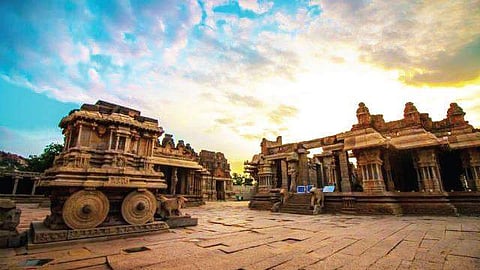

Sage Narada once came to Kailasa with a mango and gifted it to Lord Shiva. The sage claimed one can attain atmabrahmavidya—the knowledge of divine self—by consuming the fruit. Narada has a reputation of a troublemaker and true to his nature, he had brought only one mango to a home where there were two kids—Karthikeya and Ganesha.
The siblings fought.
Their mother offered to cut the fruit, but Narada said the fruit will lose its powers unless it is consumed in whole. He suggested a competition be held between Ganesha and Karthikeya. He said they would have to go around the world thrice and the winner can have the special fruit.
Karthikeya took off in his peacock. Ganesha knew he would lose as his mouse was no match for the peacock. So, he went around his parents thrice and said his parents are his world. Who would not be pleased to hear such words? They handed the mango to Ganesha. When poor Karthikeya came back, Ganesha was already finishing it off. Most children grow up hearing this popular story. Indians are remarkable story-tellers. We tell stories convenient to us. Stories have no beginnings or ends, and the narrator chooses a convenient ending. This story often ends with an appreciation of Ganesha’s ingenuity. The child hearing the story will imbibe the value of choosing shortcuts. The foundations of Indian Jugaad is laid.
Jugaad is a Hinglish term that means making things work somehow. It has become a national disease. Books are written on how innovative Indians are because we can hack low-cost solutions. Myths are made on how ‘we are like that only’ and we have relished this tag. It makes us appear clever and superior. Indians have zero respect for processes, for we do everything in the Indian way—the great Jugaad. We tell ourselves this fantastic but flawed story that there is something special about the Indian brain that is capable of such smartness in working around any obstacles, by ignoring the process, because, we are all last-minute warriors. Keeping time is a western concept, we say.
In the last Commonwealth Games in New Delhi, things were in a total mess even at the 11th hour, but we somehow pulled out a Jugaad to run the show. We patted ourselves on our backs while the entire world watched in disbelief.
It would be worthwhile to examine the myths we tell about ourselves. The irony is that we are one of the most time-bound civilisations. Many of us follow ‘muhurat’—the auspicious time for every important event in our life. We do not dare be late and follow the time to the T. But we break all rules as following them makes us appear stupid like Karthikeya. This is most clear on our roads, and Indian driving is the greatest Jugaad.
What is surprising is that we have inherited a culture that had created detailed manuals for each human activity and has strict rules on what ritual has to be done when, where and how. We abhor standardisation and claim it will stifle creativity, yet traditional Indian art forms—both performing and static—follow strict standardisation. They also allow creativity to flourish. We fail to observe the standardisation practised in ancient Indian temple buildings and ignore how creative the builders were within the limits of the standardisation. Even chanting of Vedas has strict rules of diction. This has been followed without a change for many thousand years, yet we proudly say that standardisation will not work.
We cannot build systems and process that last as we are very innovative people we claim, yet we were the ones who created the despised caste system which even spelt out how much distance each caste should keep against each other. The system withstood the ravages of time and continues to plague our lives.
A civilisation that built the Taj Mahal, Brihadeswara Temple, Konark, Hampi, Ajanta and countless others cannot now build a pavement that is even, or a building that does not leak. The civilisation that could raise the towers of Madurai Meenakshi Temple or Qutb Minar cannot raise an electric post that stands straight. One wonders how a civilisation that relished the poetic carvings of Halebeed can tolerate such a monstrosity.
That is what Jugaad has given us, a run-of-the-mill society. Everything is all right in India if it works even if barely. Smartness is in finding shortcuts. No wonder, our contribution to modern science and humanity is negligible. There has been no substantial innovation that came from India that has changed humanity in the last few 100 years. We are busy Jugaading our lives. What has gone wrong? Perhaps the story narrated in the beginning holds the key. The story does not end with Ganesha winning. Karthikeya is livid and he leaves Kailasa and goes to Palani Hills as a mendicant.
Shiva pleads with him to return, but Karthikeya refuses. He advises Shiva on the meaning of pranava, the Om and the process to achieve atmabrahmavidya. This was how the story was told in an India when we were building great temples, inventing steel, flourishing in maths and science and were the leading light of humanity. Now we delight in our ancient glories and do Jugaad while bad-mouthing the civilisations that have marched past us.
We desperately try to prove that every invention that happens was invented during the Vedic period and continue to tell stories that suits us.
mail@asura.co.in